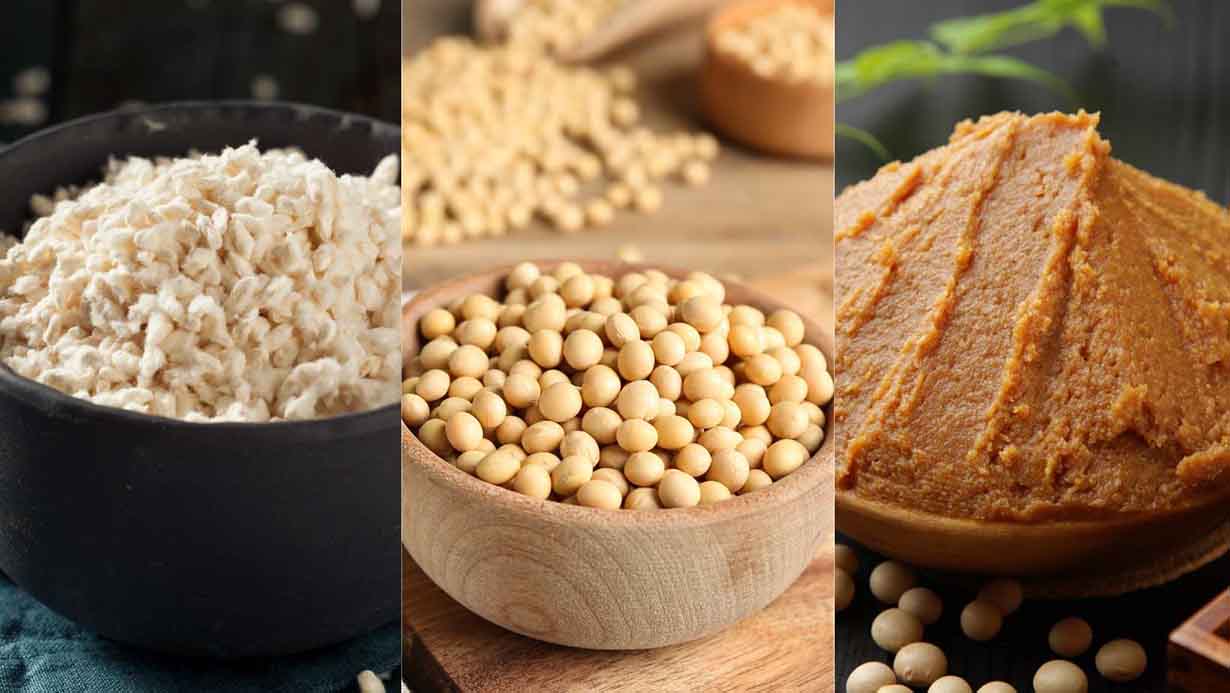
“There’s a whole of world miso to explore - find your favourite! That’s what I do… “ Tim Anderson.
Packed with umami and one of the most versatile ingredients of Japan’s store cupboard essentials. It’s many things all at once; sweet, salty and fragrant. It seasons and enriches dishes in ways no other ingredient can.
The remarkably complex flavour is created with just four ingredients. The secret of countless different types of miso is in the balance of these ingredients with the fermentation and ageing process.
But What Is Miso, How do you use Miso, and What are ALL these different types?
It’s no surprise that the world of miso can feel a little confusing, daunting even, at first. There’s White Miso, Red Miso, Yellow, Miso, Barley Miso, Black Miso, Yuzu Miso, Double Fermented Miso, Premium Miso, Artisan Miso, Mugi Miso, Aka Miso, Shiro Miso…. And more…
But fortunately, once you’ve unravelled the basics, understanding miso, and knowing how to use it, is actually pretty simple and much less mysterious than it would have you believe at first glance.
● Watch our video with Tim Anderson, where he explains the differences between different styles of miso, or read on to find out.
What Is Miso?
Miso is a fermented soybean paste that is traditionally used to add umami to Japanese dishes. It is truly a hero ingredient and its use is in no way limited to Japanese cooking. Miso is comprised of 4 main ingredients. Koji, Soybeans, salt and another grain - usually rice or barley, or sometimes a mixture of both.
How is Miso Made?
In miso making, a mould called koji is grown on rice barley, wheat or soybeans, to create a fermentation starter. The choice of grain used is carefully selected as it influences the final flavour. This koji starter is added to steamed soybeans to multiply. It is then mashed together with sea salt and spring water before being added to aged wooden barrels and left to ferment from anything for a few months, to a few years.

What is Koji?
Koji mould (Aspergillus oryzae or a related species of this filamentous fungi) is the foundation for many fermented, umami based Japanese foods including miso, soy sauce, vinegar and sake.
What Types of Miso Are There?
The duration of fermentation of a particular miso, alters the flavour and determines whether the miso will be known as White, Yellow or Red. This is how you’ll most often see miso types described. However - the colour (which isn’t even always actually the colour) only tell us how long the miso has fermented for, and therefore how strong and rich the flavour will be.
White miso, (Shiro Miso) will be aged for as little 3 months it uses more koji and less grains to speed up the fermentation process. It’s often made with rice (not always), it has a more subtle, sweet and delicate flavour.
Yellow Miso (Shinshu Miso) ferments for longer ageing and delivers a stronger, rustic flavour, it’s often made with barley, or a mix of barley and rice (Awase Miso).
Red Miso (Aka Miso) is fermented the longest, in some cases for more than two years . Often made with barley koji and sometimes only with soybean koji to deliver the richest, darkest miso that has a powerful almost beefy umami flavour. Red Miso is what Miso Soup is traditionally made with, however you can make miso soup with any miso you choose. Try them all!
● Get to know your miso better! Take a deeper dive into the different types miso

Chef Tim Anderson’s Top Tips for Using Miso
Chef Tim Anderson, Foodie Broadcaster, Winner of Masterchef and Best-Selling author of some of our favourite cookbooks such as Tokyo Stories and Vegan Japaneasy gives us his top tips for using miso in this video.
1. Try Miso as a Salt Substitute
Chef, Food writer and Japanese Specialist, Tim Anderson suggests using miso anywhere you would use salt. We’ve tried it and can confirm this is great advice! It works in sweet as well as savoury cooking.
2. Find Your Favourite Miso
Try them all and find your favourite. With such a variety to choose from it’s really worth getting to know them well enough to choose your favourite. Every chef and cook has their favourite - Tim suggests finding a good Awase (mixed barley and rice) Miso for general purpose and then using a dark miso in rich toffee and caramel desserts.
3. Always Try Miso On Its Own First
When you have a new packet or pot of miso, you have to first try it straight out of the pot or pouch before you do anything else with it. This is how you get to know and understand it.
4. White, Yellow or Red Miso?
As a general rule, the lighter the miso, the more subtle and delicate the flavour. For more intense, umami richness, go for the medium to darker varieties.
5. All Miso Is Different
So always taste to test, start small and add more if necessary. A little miso goes a long way.
How to Use Miso
Miso soup is wonderful - we will never take away from that. BUT miso is also SO much more…
- Add a spoon or two of your miso to soups and casseroles to boost all the flavours and bring them all together with added richness.

- Mix it into marinades and glazes - miso is great for giving depth and richness to vegetarian dishes, but it also does a great job at making meat even ‘meatier’.

- Try it instead of butter on your toast as a healthy alternative.
- Add to creamy dishes such as mash and white sauces to enrich the creaminess without adding fat and cholesterol.

- Make your own Miso mayo by mixing it into ready-prepared mayo or add to your homemade mayo recipe
- Add a little to any salad dressing to punch it with a little something more interesting.

- Replace salt in your salted caramel sauces and toffee-type desserts to elevate them to a whole new level of deliciousness.

- Pimp up your pesto! As well as tasting incredible, swapping parmesan for miso also makes any pesto vegan and delivers just the right kind of fermented tang in any pesto recipe.
- Add to risottos in place of parmesan, see @TokyoPony's recipe for Shiitake and Miso Risotto here
Of course - miso is most famous for a hearty healthy soup but you can see the uses for miso are infinite, which is why we award it hero ingredient status!
See our really easy and very delicious quick miso soup recipe.

Where is Miso From?
The earliest records of miso in Japan appear during the Yayoi Period (300B.C-300A.D). During these prehistoric times, people used to ferment fish and meats using salt and as a way of preservation during the warmer months. This was the core essence of miso making and naturally evolved until Japan became the “miso heartland.” As time went on, the art of making miso was adapted, using different grains and fermenting techniques to produce the paste we know today.

